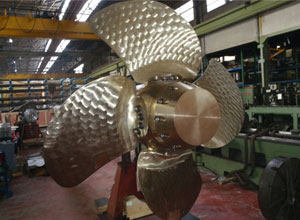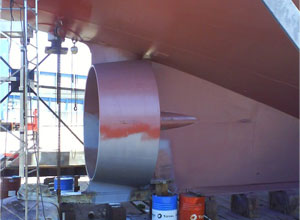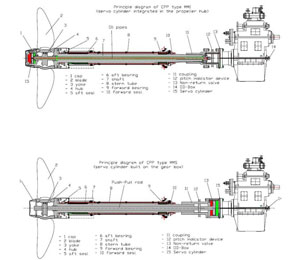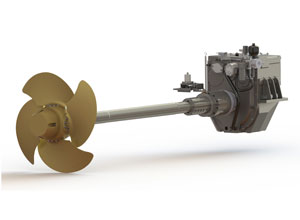Masson-Marine Propellers Offer More
Our products combine the best aspects of ZF and of FH propellers. This is because both were a part of Masson-Marine at some point in their history.
Our propellers are assembled in France or in China, depending on the geographic location and the wishes of our client.
The electric controls are easy to install and combine high flexibility and maximum safety (as for example through automatic reduction of the propeller pitch in case of overload conditions or excessive towing warp strain/ winch load).

Come-home devices are efficient and easy to use if, for any reason, the controls should be damaged.
The propeller hub is a monoblock part, thus preventing all risks of ingress of water into the propeller blade positioning system.The assembly is particularly simple.
Removal of the blades does not require the propeller shaft to be moved, even inside a nozzle.
In the MMS version, the servo cylinder is attached to the output coupling flange of the gearbox; this design allows very fast access when the piston rings have to be replaced, for instance.
The system is simple and requires minimum maintenance: all components are automatically lubricated by the hydraulic circuit.
A Complete Range of Propellers
Masson-Marine offer a range of controllable pitch propellers for professional applications and continuous operation.
We have inherited this activity from France Hélices. In fact, MM took over their activity in this area. In order to provide better service to our clients, and to extend our business, we maintain permanent efforts in research and development of our systems, thanks to our design department. Each project and every order undergoes a comprehensive case-specific study.
Please check the chart below to find out how much power can be transmitted.

Two Propeller Designs: MMI and MMS
Masson-Marine offer two types of CPP design:
- MMI (Masson-Marine Integrated): the servo cylinder controlling the blade pitch angle of the propeller is integrated into the hub. The advantage of this system is that power is transmitted to the blades through hydraulic pressure lines. This avoids the high amount of strain put on the control rod used in the MMS system. As such, this arrangement is most suitable for propellers that transmit high power. Since our propellers are provided with a leak detection device, damage does not necessarily mean dry-docking of the ship.
- MMS (Masson-Marine Separated): the servo cylinder controlling the blade angle is located inboard. The advantage of this system is that maintenance operations do not require the dry-docking of the ship.
- Please have a look at the sketches below for better understanding.

Quick Menu
New Offers & New
Products
-
New Brochure 2019-2020
 Download!
Download! -
Partnership : Become one of our agents!
 Let’s work together to reinforce and develop an effective network. Sign Up Now!
Let’s work together to reinforce and develop an effective network. Sign Up Now! -
Interactive Map : Our network at your service!
 Need new equipment or spare parts? Our interactive map is now on line. Find all of our agents with one click only!
Need new equipment or spare parts? Our interactive map is now on line. Find all of our agents with one click only! -
New gearboxes 2019-2020
 We are currently finalizing our new gearboxes 2019-2020 : W8400 and W 8450 with ratio 6,08 to 12,096 dedicated for workboats…, ask us for more details
We are currently finalizing our new gearboxes 2019-2020 : W8400 and W 8450 with ratio 6,08 to 12,096 dedicated for workboats…, ask us for more details








